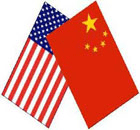Opinion
FTA is selling a bright future
By Zheng Anguang (China Daily)
Updated: 2010-01-06 07:49
 |
Large Medium Small |
As the bell chimed for the new year, we witnessed the establishment of a giant Free Trade Area (FTA) in the eastern quarter of our shared planet. With 1.9 billion consumers, a regional Gross Domestic Product (GDP) of about $6 trillion and total trade estimated at $4.5 trillion, the newly founded China-ASEAN Free Trade Area is the largest by population. According to the agreement, the average tariff rate of both sides will be reduced, with a zero tariff policy on the trade of many goods.
Surely, it is good news, especially with the effects of the economic crisis still being felt. During the past two years, when the world's finances experienced ups and downs, almost all major economies employed measures for their self-preservation. Besides the commonly-seen stimulus plans and the restructuring of financial systems, protectionism was once again raised, creating trade barriers of all kinds over the world. Even the nations where a free trade tradition has dominated for centuries resorted to economic protectionism.
It should be noted that both China and ASEAN (Association of Southeast Asian Nations) members are victims in this worldwide trend of protectionism. As important factories for the world's manufacturing industry, their main products - from iron pipes to shoes, from tires to dog food - are suffering from visible and invisible economic barriers.
The establishment of such an FTA has brought hope. In fact, ever since the Agreement on Trade in Goods (TIG) of the Framework Agreement on Comprehensive Economic Cooperation between ASEAN and China was signed in November 2004, the share of China in ASEAN's total trade has been tremendously increased, making it the third-largest trade partner of ASEAN. With free trade bridging the whole area, it is doubtless an economic boom can be expected for both sides, further propelling economic growth and benefiting residents and corporations throughout the area.
The rapidly developing and restructured Chinese economy is more connected to and complementary of ASEAN.
China is in need of and has the capability to consume a considerable amount of exports from ASEAN countries, namely wood, iron ore, rubber and numerous kinds of tropical fruits. At the same time, ASEAN is also a perfect recipient of manufacturing industries from China. Reports say some textile factories in South China are already choosing sites for expansion into neighboring countries, including Vietnam and Cambodia.
Of course, as the largest FTA by population, the China-ASEAN FTA is not without problems. The initial complexity and imbalance meant it must cope with many difficulties: For historical contradictions and economic competitions, disputes have existed for a long time, not only between China and some neighboring countries, but also among ASEAN members. Another uncertainty comes from the outside, as the so-called "China Threat" theory has never fully disappeared and there are always voices describing the peaceful rise of China as Neo-Colonialism or a threatening superpower. It is not completely impossible that the newly-founded FTA will fall victim to such rumors.
Actions from both sides are needed in dealing with such problems. As a rising power with rapid economic growth, China is expected to treat ASEAN members as equal partners, while also taking up its deserved responsibilities. The ASEAN countries should also do their best to avoid suspicion and prejudice of this equal member, and guard against talk of the "China Threat" theory, so as to maintain good relations inside the community.
In traditional Chinese culture, it is believed that miracles can be created by working together. In this age of globalization, where regional cooperation is essential for development, it is reasonable to expect that the China-ASEAN FTA will see a bright future.
The author is an associate professor at the School of International Studies of Nanjing University.













